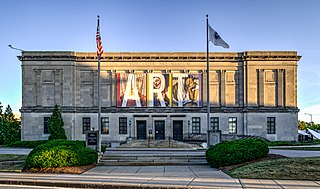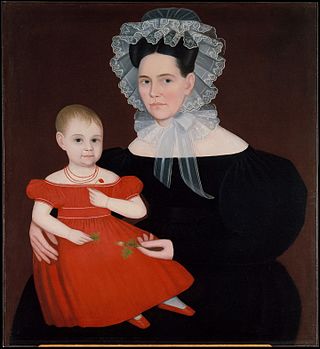
Thomas Gainsborough was an English portrait and landscape painter, draughtsman, and printmaker. Along with his rival Sir Joshua Reynolds, he is considered one of the most important British artists of the second half of the 18th century. He painted quickly, and the works of his maturity are characterised by a light palette and easy strokes. Despite being a prolific portrait painter, Gainsborough gained greater satisfaction from his landscapes. He is credited as the originator of the 18th-century British landscape school. Gainsborough was a founding member of the Royal Academy.

John Singer Sargent was an American expatriate artist, considered the "leading portrait painter of his generation" for his evocations of Edwardian-era luxury. He created roughly 900 oil paintings and more than 2,000 watercolors, as well as countless sketches and charcoal drawings. His oeuvre documents worldwide travel, from Venice to the Tyrol, Corfu, Spain, the Middle East, Montana, Maine, and Florida.

Sir Godfrey Kneller, 1st Baronet was a German-born British painter. The leading portraitist in England during the late Stuart and early Georgian eras, he served as court painter to successive English and British monarchs, including Charles II of England and George I of Great Britain. Kneller also painted scientists such as Isaac Newton, foreign monarchs such as Louis XIV of France and visitors to England such as Michael Shen Fu-Tsung. A pioneer of the kit-cat portrait, he was also commissioned by William III of England to paint eight "Hampton Court Beauties" to match a similar series of paintings of Charles II's "Windsor Beauties" that had been painted by Kneller's predecessor as court painter, Peter Lely.

John Singleton Copley was an Anglo-American painter, active in both colonial America and England. He was suspected to be born in Boston, Province of Massachusetts Bay, to Richard and Mary Singleton Copley, both Anglo-Irish. After becoming well-established as a portrait painter of the wealthy in colonial New England, he moved to London in 1774, never returning to America. In London, he met considerable success as a portraitist for the next two decades, and also painted a number of large history paintings, which were innovative in their readiness to depict modern subjects and modern dress. His later years were less successful, and he died heavily in debt. He was father of John Copley, 1st Baron Lyndhurst.

Sir Anthony van Dyck was a Flemish Baroque artist who became the leading court painter in England after success in the Spanish Netherlands and Italy.

George Romney was an English portrait painter. He was the most fashionable artist of his day, painting many leading society figures – including his artistic muse, Emma Hamilton, mistress of Lord Nelson.

Levina Teerlinc was a Flemish Renaissance miniaturist who served as a painter to the English court of Henry VIII, Edward VI, Mary I and Elizabeth I. She was the most important miniaturist at the English court between Hans Holbein the Younger and Nicholas Hilliard. Her father, Simon Bening, was a renowned book illuminator and miniature painter of the Ghent-Bruges school and probably trained her as a manuscript painter. She may have worked in her father's workshop before her marriage.

The absence of women from the canon of Western art has been a subject of inquiry and reconsideration since the early 1970s. Linda Nochlin's influential 1971 essay, "Why Have There Been No Great Women Artists?", examined the social and institutional barriers that blocked most women from entering artistic professions throughout history, prompted a new focus on women artists, their art and experiences, and contributed inspiration to the Feminist art movement. Although women artists have been involved in the making of art throughout history, their work, when compared to that of their male counterparts, has been often obfuscated, overlooked and undervalued. The Western canon has historically valued men's work over women's and attached gendered stereotypes to certain media, such as textile or fiber arts, to be primarily associated with women.

Mary Beale (née Cradock) (1633–1699) was an English portrait painter. She was part of a small band of female professional artists working in London. Beale became the main financial provider for her family through her professional work – a career she maintained from 1670/71 to the 1690s. Beale was also a writer, whose prose Discourse on Friendship of 1666 presents a scholarly, uniquely female take on the subject. Her 1663 manuscript Observations, on the materials and techniques employed "in her painting of Apricots", though not printed, is the earliest known instructional text in English written by a female painter. Praised first as a "virtuous" practitioner in "Oyl Colours" by Sir William Sanderson in his 1658 book Graphice: Or The use of the Pen and Pensil; In the Excellent Art of PAINTING, Beale's work was later commended by court painter Sir Peter Lely and, soon after her death, by the author of "An Essay towards an English-School", his account of the most noteworthy artists of her generation.

The Worcester Art Museum houses over 38,000 works of art dating from antiquity to the present day and representing cultures from all over the world. The museum opened in 1898 in Worcester, Massachusetts. Its holdings include Roman mosaics, European and American art, and a major collection of Japanese prints. Since acquiring the John Woodman Higgins Armory Collection in 2013, it is also home to the second largest collection of arms and armor in the Americas.

Ellen Day Hale was an American Impressionist painter and printmaker from Boston. She studied art in Paris and during her adult life lived in Paris, London and Boston. She exhibited at the Paris Salon and the Royal Academy of Arts. Hale wrote the book History of Art: A Study of the Lives of Leonardo, Michelangelo, Raphael, Titian, and Albrecht Dürer and mentored the next generation of New England female artists, paving the way for widespread acceptance of female artists.

Ammi Phillips was a prolific American itinerant portrait painter active from the mid 1810s to the early 1860s in Connecticut, Massachusetts, and New York. His artwork is identified as folk art, primitive art, provincial art, and itinerant art without consensus among scholars, pointing to the enigmatic nature of his work and life. He is attributed to over eight hundred paintings, although only eleven are signed. While his paintings are formulaic in nature, Phillips paintings were under constant construction, evolving as he added or discarded what he found successful, while taking care to add personal details that spoke to the identity of those who hired him. He is most famous for his portraits of children in red, although children only account for ten percent of his entire body of work. The most well known of this series, Girl in Red Dress with Cat and Dog, would be sold for one million dollars, a first for folk art. His paintings hung mostly unidentified, spare for some recognition in the collections like those of Edward Duff Balken, for decades until his oeuvre was reconstructed by Barbara Holdridge and Larry Holdridge, collectors and students of American folk art, with the support of the art historian Mary Black. Ammi Phillip's body of work was expanded upon their discovery that the mysterious paintings of a "Kent Limner" and "Border Limner" were indeed his.

Sir Peter Lely was a painter of Dutch origin whose career was nearly all spent in England, where he became the dominant portrait painter to the court. He became a naturalised British subject and was knighted in 1679.

Henry Taylor Lamb was an Australian-born British painter. A follower of Augustus John, Lamb was a founder member of the Camden Town Group in 1911 and of the London Group in 1913.

Lilly Martin Spencer was one of the most popular and widely reproduced American female genre painters in the mid-nineteenth century. She primarily painted domestic scenes, paintings of women and children in a warm happy atmosphere, although over the course of her career she would also come to paint works of varying style and subject matter, including the portraits of famous individuals such as suffragist Elizabeth Cady Stanton. Although she did have an audience for her work, Spencer had difficulties earning a living as a professional painter and faced financial trouble for much of her adult life.

The Cusco School or Cuzco School, was a Roman Catholic artistic tradition based in Cusco, Peru during the Colonial period, in the 16th, 17th and 18th centuries. It was not limited to Cusco only, but spread to other cities in the Andes, as well as to present day Ecuador and Bolivia.

Henri Jean-Baptiste Victoire Fradelle (1778–1865) was a Franco-English Victorian painter and portraitist, specializing in literary, historical, and religious subjects. For more than a hundred years, he was confused with his son, Henry Joseph Fradelle (1805–1872), who was trained as an artist but had several professions, including infirmary supervisor. It was only in the first decade of the 21st century that this mistake was identified and that biographies, lists, and auction houses gave Fradelle his rightful name.

Emily Sartain was an American painter and engraver. She was the first woman in Europe and the United States to practice the art of mezzotint engraving, and the only woman to win a gold medal at the 1876 World Fair in Philadelphia. Sartain became a nationally recognized art educator and was the director of the Philadelphia School of Design for Women from 1866 to 1920. Her father, John Sartain, and three of her brothers, William, Henry and Samuel were artists. Before she entered the Pennsylvania Academy of the Fine Arts and studied abroad, her father took her on a Grand Tour of Europe. She helped found the New Century Club for working and professional women, and the professional women's art clubs, The Plastic Club and The Three Arts Club.

Richard Phelps (1710–1785) was an 18th-century English portrait painter and designer. He painted portraits of gentry, a number of which are in the National Trust, Dunster Castle, University of Oxford, National Portrait Gallery, London, and other museums. The British Museum has an album of 312 of his drawings. Phelps was also a landscape designer, who was hired by Henry Fownes Luttrell to update the grounds of Dunster Castle.

Fanny Eaton was a Jamaican-born artist's model and domestic worker. She is best known as a model for the Pre-Raphaelite Brotherhood and their circle in England between 1859 and 1867. Her public debut was in Simeon Solomon's painting The Mother of Moses, which was exhibited at the Royal Academy in 1860. She was also featured in works by Dante Gabriel Rossetti, John Everett Millais, Joanna Mary Boyce, Rebecca Solomon, and others.




















